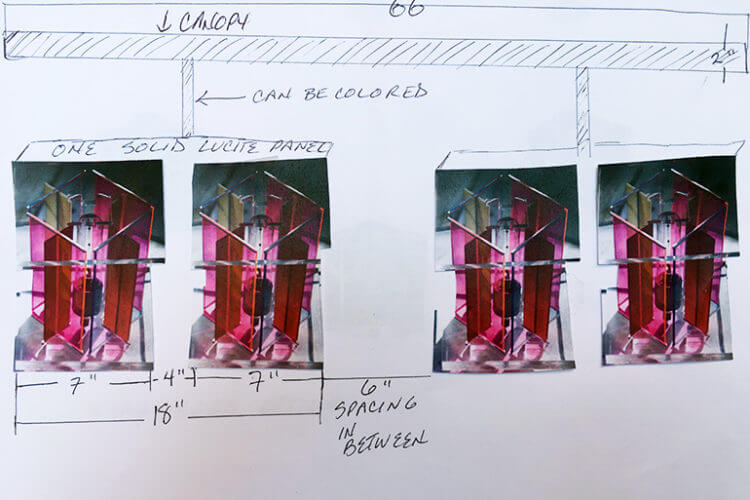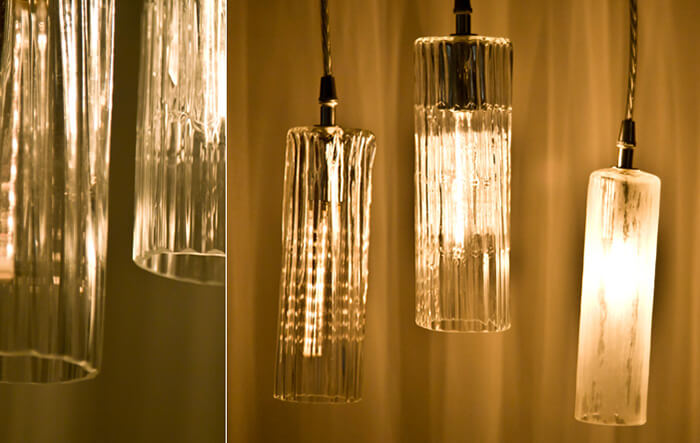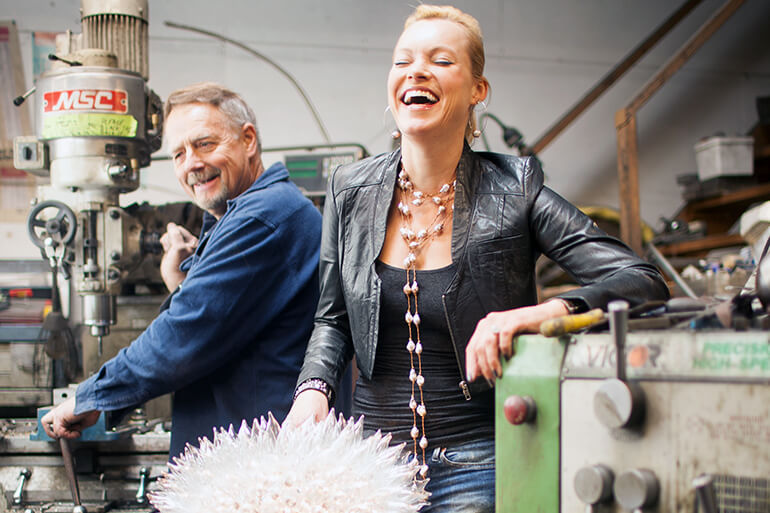The role and influence of fine artists can never be underestimated when it comes to quality design, but only a select few gifted aesthetes can trace a direct path to these masterful progenitors. For Sag Harbor lighting designer Helen Gifford, some of history’s greatest visual artists play an unexpected and powerful part in shaping her unique vision. It’s no wonder she found almost instant success.
Where some budding designers might look to Le Corbusier or Verner Panton for inspiration, Gifford conjured the Dada spirit of Marcel Duchamp, with a sprinkling of glass artist Dale Chihuly, for her very first working light fixture prototype–the now much sought after Urchin. She used dozens of light bulbs to construct the body of the fixture, which resembled a sea urchin in shape and texture, but none of the bulbs produced light.

Just as Duchamp displayed a urinal out of context for his infamous “Fountain” or showed everyday objects as ornamental “Readymades,” Gifford embraced the idea of, as she puts it, “rendering something useful useless.”
Her cluster of bulbs was purely decorative and illuminated from a single source within–a paradox made physical. The inventive piece offered aesthetic beauty and practical functionality, but it stood out for thoughtfully bridging the divide between fine art and design. It also spoke to green concerns by reusing bulbs that might otherwise be discarded.
Nearly two decades ago, Gifford showed Urchin as her final project for a furniture design class at Parsons and it attracted interest immediately. Admirers encouraged her to “go for it” and market her creation. “It surprised us all–me, teacher, critics at final review–so I took their advice to send images to the places I wanted to sell my work,” Gifford recalls. “I went straight to SoHo.”
Around the same time, Gifford brought her design to the 1999 International Contemporary Furniture Fair (ICFF) where it was quickly scooped up by Plug Lighting, a Los Angeles-based store and showroom. As if things weren’t going beautifully enough, her star was about to shine even brighter.
Pointing to the immense power of celebrity, especially in L.A., Gifford says her work found its way into some well-heeled homes, which in turn appeared in magazine profiles that brought her to the national stage. She was suddenly thrust into running her own business, HelenBilt, but Gifford rose to the challenge.

Soon her designs were in multiple showrooms and retail stores, and Gifford found herself installing HelenBilt fixtures in homes and businesses worldwide. Eventually she was called to make big statement pieces, branding the lobbies of high profile hotels such as the Ritz-Carlton Beijing, W Hotels in Ft. Lauderdale and San Diego, and ARIA Resort & Casino Las Vegas with unforgettable signature lighting.
Early on, as HelenBilt grew, Gifford struggled to manage in New York City and Brooklyn, so she packed up and went east to the Hamptons. “I was starting to do some big projects,” she says. “They just wouldn’t fit in the elevator.” Besides, “I’m really, really an outdoors kind of person,” Gifford explains. “The first opportunity I found to come to the Hamptons, I took it.”
She started in a big barn in Quogue, and then migrated to Southampton before finally landing in her home and studio in Sag Harbor. Over these pivotal years, Gifford also began to branch out and expand, earning a degree in environmental design, policy and planning, and putting together three distinct lighting collections.
After establishing her Urchin designs, Gifford created her “Concord” collection, inspired by American sculptor Donald Judd. Featuring colored Italian Lucite and tinted polycarbonate panels; the precise, geometric designs create a sort of plaid aesthetic while also invoking Judd’s minimalist approach.
“It’s always the art shows that inform what I make,” Gifford explains.
For HelenBilt’s third collection, the blown glass-based “Vidro,” Gifford says, “I needed something that could create a nice line that’s limitless.” Made to order, the collection allows for continuous evolution while maintaining an overall cohesion.
“All the pieces have a story,” the designer says, first pointing to her spherical and bubbled Bolhas fixtures, which feel buoyant, like champagne and celebration.

Other Vidro designs include Tebu, a delicate tubular series influenced by bamboo shoots; Valo, based on an antique Bordeaux wine mold; and Clecian, “hand-blown and crackled to reference unearthed artifacts of the Masai Mara Rift Valley,” to name just a few designs in the ever-growing range. “Glass is truly the most versatile material,” Gifford says.
To fabricate her light fixtures, she begins with rudimentary drawings and site-specific photographs, and then collaborates with a select group of East End artisans and craftsmen–all within a 15-mile radius of her Sag Harbor home. They usually create computer-generated CAD designs before diving into construction.
Gifford can be seen riding her bicycle to visit workshops or studios and meet with folks such as Southampton machinist Gary Anderson or electrician Michael Riccio. “The whole focus is that we are custom or retrofitted,” she says, crediting her outsourced team with immense talent and creativity. “However we can make it happen.”
Resolute about never opening her own store, Gifford keeps her artistic heart free from 9-to-5 confines and leaves sales to others. Instead, she is constantly developing new ideas. She recently added wallpaper to her repertoire and is now looking toward textiles, such as throws and pillows. “Lighting, wall covering and textiles are the trifecta of interior design,” Gifford says. “The underpainting of interior design.”
Ever the art lover, she also hopes to one day create “an incredible wall-sized installation,” like something at Storm King, the outdoor sculpture park in Upstate New York–art for art’s sake.
Creativity and industriousness rule Gifford’s world, no matter what she decides to do. It’s all about “the way we as people are trying to move forward,” she says, “not resting on the way things have always been.” Looking at Gifford’s life and body of work, this couldn’t be more clear.
See more of Helen Gifford’s work and projects at helenbilt.com.























